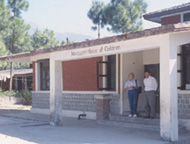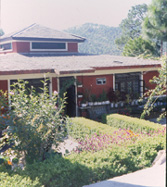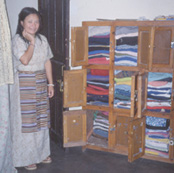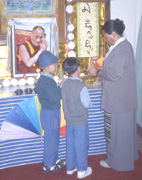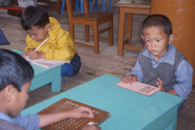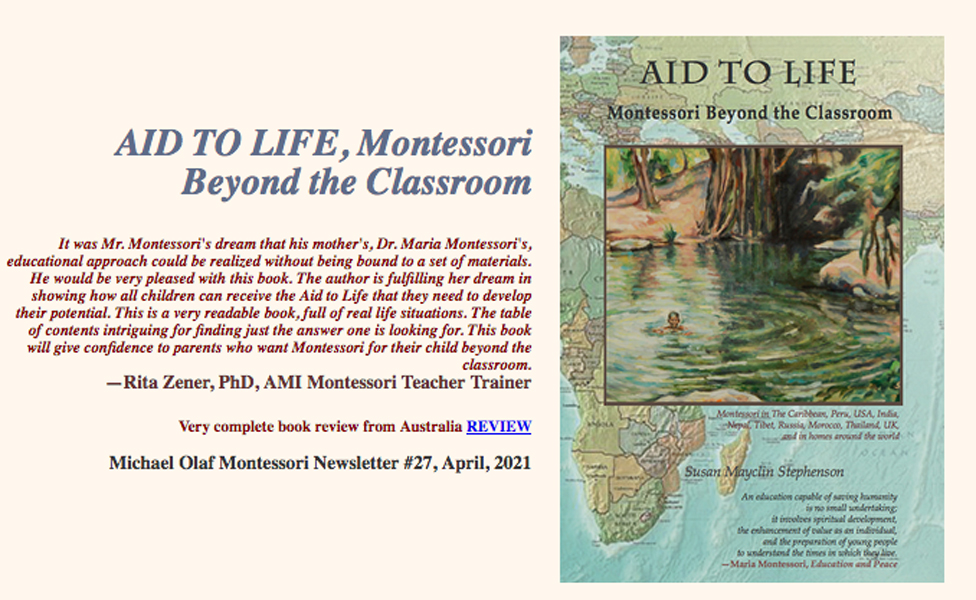9/21/2002 - Hello, When I arrived in India all flights to Dharamsala from Delhi
had been canceled until further notice. That means I get to see 14 hours
of India—the Punjab plains and the Himalayan foothills—up close!
I learned to "post" in the back seat of a tiny car with no seat
belts, driving and passing cars at mostly one fast speed, over bumpy roads
that reminded me very much of our own potted driveway at home, plus landslides,
washouts (the monsoons have just ended) and of course lovely slow silent
religiously-protected cattle taking precedence over anyone else.
We started out in Delhi with air conditioning
as the temperature was over 110 degrees, but I could see that it was making
the driver ill -- his eyes were turning red in the mirror and he was starting
to cough so I told him it was cold and asked if he could turn it off.
He was SO happy. And then we could see, and smell and feel India - instead
of watching it through a television screen car window. It is a good thing
that it was dark for the last two hours in the mountains where many of
the landslides were - I won't say anything more about that. You can imagine
that after a very full day of travel I have a lot more to say, but I would
like to get out and explore. The main point I would like to make is that
the trip by car yesterday was really wonderful! You can look "McLeod
Ganj" up on google.com if you like - and I will write more later.
9/23/2002 – Did I tell
you about the dream I had about the Dalai Lama a few weeks ago? I dreamed
I was walking down a country road and I saw him coming toward me. As we
got close to each other I took an IMAGINARY kata (you know, the white
scarf of greeting) from around my neck and held it out to him. He smiled,
pretended to see it, held out his hands for it, took it and pretended
to place it around his neck, all with his calm twinkling smile. Well,
guess what? This morning I was walking down a country road (a mile long
one, downhill, on the edge of a ravine) to go to a lecture on Tibetan
philosophy at the library in lower Dharamsala. On the way I saw many crowds
of people, small and larger groups, with flowers, incense, waiting for
something. After awhile I asked and was told that the Dalai Lama was coming
-- on his way to the government building for a meeting about women's rights.
So I sat down on a rock by the side of the road and waited. Soon I heard
those amazing haunting Tibetan horns from the bottom of the hill, and
the sound of a car coming. First came a whole car of soldiers, then a
lovely light yellow car. It was the Dalai Lama. He was in the front seat
on my side, they drove slowly. As they came up to me, he smiled and I
smiled back. Can you imagine? I was so happy.
At the break of the lecture I helped a 30-year-old monk with his English.
He had escaped from Tibet when he was 19 and he traveled in the USA for
8 months with 12 other monks, visiting, among other places, some "save
Tibet" student organizations and universities. I am having a wonderful
time.
TOP
9/26/2002 - Each day I leave at
8 am to walk the 2-3 miles to the library of Tibetan Works and Archives
for philosophy classes from 9-12, with a break for spinach momos (little
dumplings) and chai at a stand outside the library. Then at night I must
get back before dark because I am exhausted from not taking a break all
day. And I want to be able to avoid the cow pies and other garbage that
is difficult to detect in the failing dark.
A few days ago I met two nuns trying to learn email in a cyber cafe so
now am teaching them email and English. I went today,, with a new friend
from Switzerland, a woman who has been coming here helping the TCV (Tibetan
Children's Village) for 13 years, to the nunnery, which is a double row
of shacks up the mountain. Two nuns live in a room a little smaller than
a dorm room. It is their kitchen, living, bed, everything space. The ceiling
is plastic stuffed with something to keep out the cold and we can hear
mice running around while we drink tea and laugh and practice English.
There is a 2-inch gap below the door where the wind howls in. But they
are so happy and joyful. Today there were three in the class, the head
nuns of the nunnery, one Ladakh, one from Sri Lanka, one from southern
India -- all from large Tibetan refugee families. I asked them what they
want to be able to talk about most in English. They began with these questions
that they get asked a lot: "Why did you become a nun?" "What
is your goal or aim in life?" We discussed it and they came up with
these answers: I became a nun so I could get an education and because
I believe in helping people. And: My aim is to become enlightened,
a wiser and better person, and to return to my village to teach English,
computers, and Tibetan philosophy to others. I gave them an assignment,
a list of other things to write about.
Yesterday I went to the Tibetan Children's Village. I took pictures and
slides of the Montessori classes -- which are among the best I have seen
in a long time. One class had 90 children, 90% of them concentrating on
work, completely oblivious of my walking around and taking pictures. Some
of the children with bruises; some refugee children have had amputations
because of frostbite from escaping China. One had been abandoned by his
Indian soldier father after his mother disappeared. (They take non-Tibetan
children who need help.) The Tibetans in now China-occupied old Tibet
cannot leave, but they can smuggle out their children who travel over
snow-covered mountains to get to a place where they can live in freedom
and not be in fear of imprisonment and torture if they say the wrong thing.
The head of the Montessori section had just finished reading Michael
Olaf's Joyful Child (Montessori for birth to three) and is interested
in taking the training, the 0-3 Montessori training outlined in it. I
shall try to help him with this. He was very happy with the books, tapes,
etc. I brought them -- and the boxes resent -- they have all arrived!!
(NOTE: since I returned, Judi Orion, of the Assistants to Infancy training
course in Denver Colorado, has donated a full tuition scholarship for
a Tibetan teacher. Thank you Judi!!!!!!!)
On Saturday all of the teachers are watching
the Wonderful Two's video I brought them (of the Montessori 0-3
classes in Japan and Denver) and reading our printout of the 3-hour work
period. Then the next Saturday I will meet with them and give a little
talk.
9/29/2002 – Tonight when I was coming home with a bag of bananas
in one hand, and a purse/bag in the other, a large monkey came at me with
his eyes burning with excitement focused intently on the bag of bananas
(How did he know?) and licking his lips in anticipation (most disturbing).
I yelled and swung the bag at him and ran (can't you just picture me running
from a monkey!!!). On the trip from Delhi I saw monkeys a few times and
was afraid I was never going to get a photograph of them -- ha! Yesterday
I took pictures of them grabbing the garbage on my road into town and
jumping into the trees with bags, looking to see if there is anything
good to eat, then tossing tiny bits to the babies. It is so nice to see
them free; they look so much like us that it has been terrible to see
them in cages.
Yesterday morning our hostess knocked
on my door to say that he was in Puja (prayer) at the temple with his
monks from 6-9 am, so Helen, my next-door neighbor in the guest house,
and I rushed down. It was wonderful to be sitting there, welcome and surrounded
by hundreds of old and young Tibetans, chanting prayers for the world,
using their rosaries and prayer wheels, occasionally joined by horns,
drums and bells from inside the temple. We were all seated on the patio
surrounding the main room, which was open to us so we could see everything.
Later people lined up to meet the Dalai Lama, first those people in wheel
chairs, crutches, and old people who might not get another chance. I was
about number 40 in line and was so happy to get a chance to meet and shake
the hand of a man who is such a loving leader of his people.
10/02/2002 - What a place to be on Gandhi's birthday! I went to
the TIPA (Tibetan Institute of Performing Arts) for an Indian-Tibetan
dance performance of children from many of the local schools. The Tibetans
and Indians alternated with their performances, from beautiful classical
Nepali and Indian costumed dances, to a group of little boys being "Tibetan
Horseman" showing that they could gallop around the stage to horse
drumbeats while eating, drinking, and reading the newspaper! Yes, I took
pictures.
Yesterday I gave a talk at the Tibetan Children's village to about 15
teachers. It seems to have been well received because afterwards everyone
asked questions, even the headmaster, and we discussed many things, laughed
a lot (my specialty) and had our picture taken together.
Also yesterday I went to the Men Tse Khang, the Tibetan Medical and Astrological
Institute, to see a doctor, just to see what it was like. I was diagnosed
as having arthritis (hmm – I thought this pain in getting out of
bed in the morning and walking down the stairs was just normal for my
age!!!). This is one of the chronic conditions that Tibetan medicine is
famous for helping. First I waited on white benches with about 20 Tibetans.
The "number" window opened (numbers are passed out to see the
3 doctors). When it was my turn, the doctor, a bright young woman in her
30’s, felt my pulse and told me exactly where my back hurt. Then
she took my blood pressure, and then a resident felt my pulse, maybe to
see if he felt the same thing. (Medical school is ten years here) I am
taking giant "dirt" pills (they must be chewed up and swallowed
with hot water and taste really bitter) before breakfast and after lunch
and dinner and have an appointment in 7 days to see if it is making a
difference. The consultation and medicine for a week cost less than two
dollars US (70 rupees). (NOTE - now, in January, 2003, I am completely
out of pain.)
Last night I saw the movie Monsoon Wedding in a theater that has two seats
on either side of the aisle, and about 10 rows (like the plane to Arcata
from San Francisco). Coming out of the theatre was a bit confusing as
I felt that I was still inside. It was a very good movie.
TOP
10/03/2002 –
Here are the answers to questions that I have been asked by email:
"What about water Susan?" The
water comes from even higher in the Himalayas. Every morning it is turned
on and all the tanks in town are filled. There are a lot of leaks, little
fountains and streamlets. I fill a liter container with water from the
tap, add 2 drops of iodine and let it sit, later filtering it through
another 1/2 liter container with a 1-micron filter. I use this for brushing
teeth, heating a glass at a time with a little immersion coil to take
medicine. I keep my mouth closed while bathing to keep water out. And
drink mostly tea and hot ginger or lemon water in restaurants.
"How do you spend a typical day?" Wake, sit up, meditate/pray,
heat water (coil for medicine, turn on heater in bathroom for bathing).
Make bed, shower, dress, meditate/pray again. Either have milk tea on
the terrace with my neighbor Helen or leave for class if there is a 9:00
class, which there usually is. Between classes teach English at the little
coffee shop next to the library. At noon explore, take pictures, maybe
eat, do special stuff, have fascinating conversations with the foreigners
who come here, or the local people, teach, have clothing made at the Kotwali
Bazaar of Hindu tailors (I prefer to be not so conspicuous in Western
dress), do email. Buy fresh fruit for breakfast (bananas or apples which
I wash later in iodine water). Look at stuff to buy to sell through Michael
Olaf (to help pay for my trip, and to pay for the many things we send
to the Tibetan Children's Village from Michael Olaf.) I am checking to
see WHO makes the things I buy -- good quality and no slave labor.
"What are you studying at the library?" The book we are using
now is Shantideva's Guide to the Bodhisattva's Way of Life. I earned
a degree in philosophy years ago and this is similar but different; everything
we study has practical applications for a good life in today's world.
A Bodhisattva is someone who has such incredible compassion for
mankind that he/she has decided to help all others before him or herself,
to help them to become happy and free from suffering. We study things
like anger, patience, effort, enthusiasm, and wisdom in detail. For example,
three types of laziness (1) being attached to activities that waste our
time and energies and life, (2) putting off spiritual practice, worship
"for later"", (3) being negative and hopeless about the
whole idea of becoming a better person.
10/04/2002 - Last night I was in
a tiny, dark Italian restaurant, next table a man who looked exactly like
Richard Gere (who has done a LOT for the Tibetans), then this afternoon
in the paper (referring to a 5-day conference here on "Science and
the Mind") I read:
At Mcleodganj, (where I am staying), Stars Twinkle for Compassion
The subject was the stars, the stars mere participants. But then, when
the dialogue centers on the Nature of Matter, the Nature of Life, and
the presiding deity, none other than the Dalai Lama, the celeb quotient
does cease to exist. So Hollywood heartthrobs Richard Gere, dashing in
an olive T-shirt, and Goldie Hawn, floating around in a sheer golden cape,
occupied the humble seat of mere observers, as did Dan Goleman, author
of "The Emotional Intelligence," while Steven Chu, a Nobel laureate
in Physics, and Eric Lander, a leading genome expert, were pegged a rung
higher as participants here today. A gathering with enough star power
to generate mass hysteria elsewhere, but here at Mcleodganj, life flowed
at its placid pace. No heads turned when Gere and Hawn decided to leg
it to Chonor Guesthouse (where Susan has twice eaten lunch), a
good 10-minute walk from His Holiness’ residence, after the morning
session on Day 3.. .
Sorry, I'm not going to type the whole article. You can look it up on
the internet at The Indian Express, Thursday, October 3rd, if it doesn’t
open to the right page you can still search by date: http://www.indianexpress.com/archive_frame.php,
and here is the website for the Mind and Life Institute (Boulder, Colorado),
which sponsored this conference: http://www.mindandlife.org |
10/?/2002 - I mentioned the very
interesting people who come here. Well, Helen Strunc has been my guide
and friend since the first day. She is Australian by upbringing, US by
citizenship, and lives in Switzerland with her husband Vladimir who was
a Czech refugee. They have been just about everywhere, especially in Asia,
and I love listening to her stories. She is 13 years older than I am and
has been coming here annually for years. Ed Douglas was Vice-president
of Marketing for Mindspring.com and Earthlink.com and now lives here,
helping the Tibetans. He is working with the Tibetan government to devise
a program to prepare upper level students for work in the world. Isabel
Losada is a writer from London who has published a book that inspired
her to do another on how people can help the Tibetan cause. Before she
left for home she had a talk with the Dalai Lama on the subject -- and
just about everyone else she could corner. Very bright, interesting, kind,
young people.
At 7:30 on Friday the Montessori head of the TCV Montessori classes took
me to a beautiful school in Golbalpur. Here there are over 1000 students
from age 3-18. An "Ama-la" who cares for 26 boys and girls from
age 6-13 showed us through her children's house, one dorm room for girls,
one for boys, a worship/dinning room, and simple kitchen and the Amala's
room, then the garden. I hope I can show you pictures some day. The parents
are in Tibet -- having smuggled out their children -- but this is the
most loving environment I can imagine for them under the circumstances.
The principal of this school arrived from Tibet when he was five years
old, and has studied in the US on two Fulbrights, one to study the teaching
of English at the U. of Virginia, and one to visit many Jewish summer
camps!!! To learn how to keep a language and culture alive in a world
where otherwise it might be stamped out - appropriate for the Tibetans
in India now, and hopefully in Tibet in the future. The teachers, and
about 60 children, gathered to see "The Wonderful Two's" the
video I made of the Montessori Infant communities in Japan and Denver.
One never knows where one's little projects will end up. Then we had an
interesting discussion and one of the teachers said she hoped I could
return. I certainly hope to return if I can really be of help here.
I heard a child cry yesterday. It was shocking, as I have seen only smiles.
The street was crowded and apparently he ran into a pipe. He was not hurt,
but many people, old and young, stopped what they were doing to look in
his direction with concern on their faces until it was clear that he was
all right! Such a close and loving community this is.
The monkeys have been crazy the last two nights. I wear earplugs to sleep.
A large one is jumping on the giant black plastic water tank because it
makes a tremendous noise in the night. I wish I could see the glee on
his face.
10/10/2002 - Well Dears, tomorrow I leave here and today is my
last internet day here. I'll try to write again from Delhi or SF (am giving
a talk to three religion classes, and meeting with religion teachers,
at Menlo School near San Francisco on my way home.) I want to thank you
for giving me this reason for organizing my thoughts and sharing this
amazing trip with people who care.
Yesterday I had the last English lesson with my two Buddhist nun friends.
We talked about how they spend their day. They are in prayer for 3-4 hours
-- praying for everyone on earth. I thanked them for their prayers. Each
night they must defend in debate what they are learning -- rather like
the tutor-student practice at Oxford University. They are in school to
learn enough to go back to their villages and share Tibetan Buddhist philosophy
for 15-20 years. A person who is studying logic takes at least seven years
just for that study.
I leave at 6 PM tomorrow night for the overnight bus from here to Delhi.
One little story to end this message: The other day I was walking the
long country road from my guesthouse to the library for philosophy classes.
Two little girls, perhaps four and six years of age, came onto the road
from a side path on their way to school. (I could tell because they had
on the local school uniform). They casually looked my way and then suddenly
the littlest one brightened, smiled, and ran toward me with her arms outstretched
calling "amala! amala!" (amala means mother or grandmother).
She gave me a hug. Then, the big sister took her hand and they started
back to the path on the other side of the road. Once again the little
one turned to me, stretched her arms out, called "amala" with
the glowingest, happiest smile, and came toward me with her lips puckered
for a kiss. We kissed good-bye and went our ways, me with my head shaking
in wonderment and my own happy smile.
TOP
October 22, 2002 – HOME.
I am in awe of the beautiful home and garden where we live, and struck
by the gold and reds of the fall colors which seem all the more vibrant
because I did not see them come on gradually (or just maybe because my
eyes have been opened a little wider?). I am a little bit ill due to drinking
water accidentally as I brushed my teeth in the Bangkok airport on the
flight home, and because there is a 12-hour time change between here and
Delhi but I will try to recap:
Delhi was amazing. The bus trip, the overnight trip where I was planning
to sleep, was fascinating but not conducive to sleep or rest. I have overcome
the lemming fear of cliffs; these little slopes into the Pacific are laughable
compared to the cliff roads that bus took at full speed, and safely. We
drove through tiny villages, passed people full on at living in little
cafes in the night, children, moms and dads carrying giant loads of grass
home for the winter animal food. I don’t know where they found grass
but there must be some fields tucked away between the peaks. At around
10 PM we stopped for dinner. At 6 AM we pulled into Delhi, well the outskirts
of Delhi, the Tibetan refugee camp called Majnuka Tilla, a piece of land
given to the Tibetans years ago by India, which is now so packed that
the guest houses, tiny at the base of the building, are many stories high,
and the spaces between them are tiny dark alleys, and the one main street
is about 10 feet wide. The parking lot for cars is outside the living
area. Yet, people are living the same happy, peaceful life that saw in
the mountains.
On the first day I had arranged a driver that took me around Delhi. Pulling
into the main road in NEW Delhi the first thing I saw was an elephant
and a camel! I had to roll down the window to eliminate the feeling that
I was watching this on a TV screen. We drove down wide tree and flower-lined
boulevards to the place where Gandhi was cremated, the “Raj Ghat”,
a large black marble slab with an eternal flame surrounded by acres and
acres of lawn and garden and enormous black Brahma bulls pulling lawnmowers
to keep this very special place beautiful. There was a constant stream
of visitors even this early n the morning, removing shoes and silently
walking past the flame, placing marigolds on the marble, taking pictures,
showing respect for this great person. It was very moving.
As we entered OLD Delhi the main feeling
was a steam of humanity: families of four—dad with youngster in front,
baby between him and mom on back—of motorcycles (I’m sure they
could not afford cars), bicycle rickshaws, little doorless 3-wheeled green
vehicles, and people! It is in the middle of the Hindu celebration of
Dewali so there were stands of red and gold holy fabric and religious
objects everywhere, singing, trucks with a huge display of the goddess
Kali full of young men yelling, laughing, singing, and people, crowds
of women in luscious brightly-colored saris and men in long white pajamas,
children running everywhere, fruit stands, tables of clothing, sounds,
smells—India. The rest of the day was fascinating, but not so much
because of the beautiful places we went to see (like the Lotus Temple
of the Bahai, the India Gate – and nearby modern art museum of course,
the Jama Masjid Mosque) but the people. We couldn’t get close to
the Red Fort which is a main attraction because of the Hindu celebration
bringing people out in masses to crowd streets already full in song and
ceremony. We needed translators often and just asked people in the street.
I enjoyed meeting many of the helpful, friendly Indians who helped me
communicate with the driver.
POLICE – that night, after going to sleep early because of missing
a night’s sleep on the bus from Dharamsala, I was awakened by violent
knocking at my door. And opened it to three large Indian policemen with
guns and the tiny apologetic Tibetan receptionist. It seems that I should
have written “arrived from the USA” instead of “arrived
from Bangkok” on the register when I signed in. They demanded my
passport (which was not easy to find in my collapsed condition) and to
know why I was in India. Finally satisfied with my answers they left and
I laughed myself to sleep. I do love experiences out of the ordinary.
At 5 AM the next morning I was met by a different driver, one who I had
met briefly at the travel agency in Dharamsala, to drive to Agra. It was
still night, and so interesting to see Delhi in the early dark. As we
drove through the countryside between these two cities we watch the sun
rise over lovely misted fields just a little different from home because
of the peaked straw huts outlined in the changing light – from gray
to purple, then blue, and finally glorious reds, oranges, and yellows
– and then steam through bright blue as the hot sun his the dew.
As the light barely began to show we watched the people get up and start
their day. As life is in the air instead of the little huts called home,
we could see the fires being lit, tea mixed and boiled, bathing at many
outside water sources, and everywhere people greeting each other for the
day, having breakfast, herding the goats and cattle toward the fields
. . . life.
Agra – again beautiful buildings, but I’m sure you can see them
in books -- The Taj Mahal, the Agra Fort, and the Sikandra or Akbar’s
Mausoleum where a large white monkey sat on my shoulder and ate out of
my hand. He must have weighed a lot but it didn’t matter. Again,
for me the fascination was the people in the street. And I could write
a page on so many amazing scenes of this.
One more day in Delhi, then the flight to San Francisco and a talk at
Menlo School where I friend of mine is a teacher of religion for ninth
graders. I wore the Tibetan woman’s dress “Chuba” and Helen
(my old friend, and wife of the religion teacher) wore one of the Indian
outfits that I wore often in India, the Salwar Kameez (very loose pants
with a tunic and shawl.) I showed a videotape of scenes from Dharamsala
– monks debating, the Dalai Lama’s home, my neighborhood and
the The Library of Tibetan Works and Archives, lots of monkeys, and cultural
dances by Indian and Tibetan children and adults. I played a CD of Tibetan
music, burned incense, and demonstrated and explained the use of the blessing
kata (white scarf), mala (prayer beads), singing bowl, traditional “Chod”
drum, prayer flags, Tibetan flag, and ended the session with a lesson
on prostrations, which are a way of concentrating during prayer but also
prescribed to help heal physical ailments. Some of the students really
enjoyed joining me in performing the prostrations. It is like a dream.
But I am still helping three Tibetans with their English via email and
Jim says our home smells like an Indian grocery store, so I know it is
real.
Thank you for your prayers, and support.
Tashi Delek, Susan Stephenson
P.S. As a result of this web page, at least three teachers have visited
Dharamsala, one has become a sponsor of a TCV child and another is there
now teaching English to Indian students. Montessori materials, and many
boxes of clothing, have been gathered and shipped. Several students have
become penpals and are getting to know each other across the globe. Thank
you so much for your past, present, and future help.
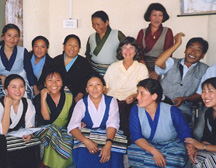
Susan with the TCV 3-6 Montessori teachers in Dharamsala, India. 2002
AUTHOR'S WEBSITE, Montessori work, art and international blog: SUSAN
MICHAEL OLAF Montessori information MICHAEL OLAF
MICHAEL OLAF Montessori shop, wholesale books for schools and teacher training centers
BOOKS & MATERIALS
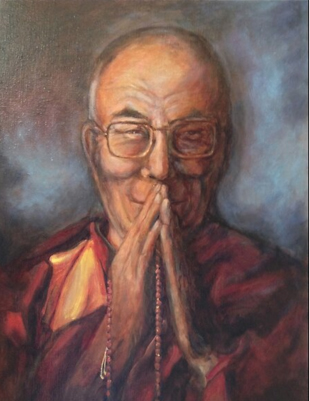
Some of Susan's art prints, made from paintings inspired by this and other trips, can be found here: ART |
